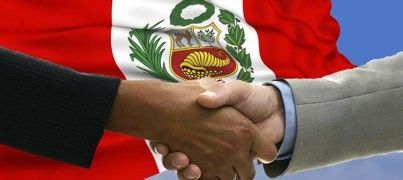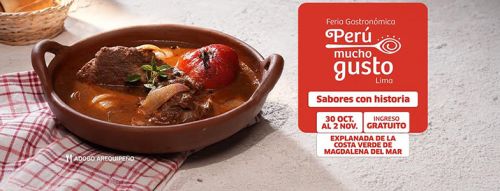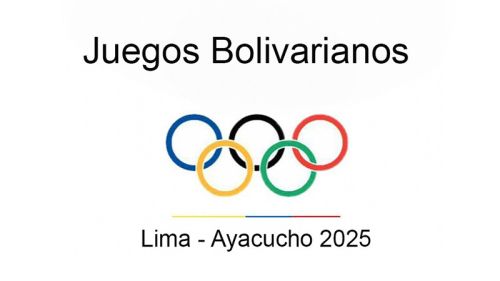Nearly 95% of Peru's exports are covered by Free Trade Agreements (FTAs) currently in force. This enables Peruvian products to enter, subject to the rules of origin of each trade agreement, under preferential conditions to 53 countries, including Canada, Chile, China, the member countries of the European Union, Japan, Singapore, South Korea, Thailand and the United States, among others.
Peru's development strategy is based on an economy open to the world and competitive in its export offer. It has been a successful strategy that has permitted the country to merge its foreign trade in goods and services as an instrument for economic development and the reduction of poverty.
International trade negotiations, which have benefited from rigorous macroeconomic management and its consequent stability, have allowed the Peruvian economy to gradually tackle and reduce its external vulnerability in times of crisis such as in the current international situation. In recent years, Peru has negotiated Free Trade Agreements (FTA) with large and medium-sized markets.
Content Overview
- Introduction
- Free Trade Agreements (FTAs) Signed by Peru
- Andean Community of Nations (CAN)
- Asia Pacific Economic Cooperation (APEC) Forum
- Peru – Chile Free Trade Agreement (FTA)
- Peru – China Free Trade Agreement (FTA)
- Peru - European Union (EU) Free Trade Agreement (FTA)
- Peru – Japan Free Trade Agreement (FTA)
- Peru – MERCOSUR Economic Complementation Agreement (ACE)
- Peru - Mexico Trade Integration Agreement
- Peru - Singapore and Peru – Thailand Free Trade Agreements (FTAs)
- Peru - South Korea Free Trade Agreement (FTA)
- Peru - United States Trade Promotion Act
- World Trade Organization (WTO)
- Future Agreements
Introduction
The market openness and the trade agreements that Peru has signed have permitted an increase in the number of exported products and exporting companies, particularly in non-traditional exports. Although exports of traditional products still represent 78% of the country's total exports, the trade agreements have allowed the country to diversify its offer of non-traditional goods. For example, in the first three years of the FTA with the United States, 488 new tariff headings were registered for non-traditional exports shipped to the United States, while 204 new non-traditional export headings were observed at the end of the second year of the FTA with China.
These trade agreements are a valuable instrument for attracting direct foreign investment and boosting increased productivity in companies, and transferring technology through the lower cost of imports of capital goods and quality inputs. Trade agreements provide an incentive to the processes of convergence of international standards, which has enabled more Peruvian companies to improve their management and logistics practices.
Peru has also negotiated Reciprocal Investment Promotion and Protection Agreements. As of this date, Peru has investment agreements with 53 countries, considering signed and in force agreements.
The principal rights protected include:
- The right to fair and equal treatment.
- The right to receive the same treatment as domestic investors.
- The right to receive an indemnity in case of expropriation.
- The right to the free transfer of profits.
- And the most favored nation clause, under which the better treatment given to Peru's partner in these matters also covers Peru's other partners in these types of investment agreements.
It should be noted that Peru has a signed agreement with the Overseas Private Investment Corporation (OPIC) and a Constitutive Agreement with the Multilateral Investment Guaranty Agency (MIGA). Peru has also signed the International Convention for Settlement of Investment Disputes (ICSID) as an alternative for resolving disputes that might arise between investors covered by the ICSID and the Peruvian State.
Free Trade Agreements (FTAs) Signed by Peru
Good international relations are of vital importance to the sustainable development of a nation. The opening up of new international markets has allowed Peru to achieve a more dynamic economy, as reflected in the signing of Free Trade Agreements (FTAs) resulting in market growth in exports. To date, Peru and its exports have benefited from a variety of regional trade agreements, multilateral agreements, and bilateral trade agreements. The following is a list of the agreements signed.
List of Trade Agreements in Force
Multilateral Agreements:
- World Trade Organization (WTO)
Regional Agreements:
- Andean Community of Nations (CAN) - Bolivia, Colombia, Ecuador, and Peru
Bilateral Agreements:
- Canada
- Chile
- China
- Costa Rica
- Cuba
- European Free Trade Association (EFTA) – Switzerland, Iceland, Liechtenstein, and Norway
- European Union
- Japan
- Mexico
- Panama
- Singapore
- South Korea
- Southern Common Market (MERCOSUR) - Argentina, Brazil, Paraguay, and Uruguay
- Thailand
- United States
- Venezuela
Pending Entry into Force:
- Guatemala
- Pacific Alliance (Colombia, Chile, Mexico, Peru)
Andean Community of Nations (CAN)
Peru is a member of CAN in agreements related to lower customs duties for goods, sub-regional liberalization of service markets, community regulations regarding intellectual property, land, air and water transport, telecommunications, etc. An important part of Peruvian trade regulations are governed by the commitments made under this forum. However, in its policy of trade liberalization with other countries and blocs, Peru deepened the liberalization of trade and the opening of its market for much higher levels, and with commitments that are broader in scope than those arising from the CAN.
Asia-Pacific Economic Cooperation (APEC) Forum
Asia-Pacific Economic Cooperation (APEC) is a forum to promote economic cooperation, economic growth, and the expansion of trade among its members. Unlike the World Trade Organization (WTO) and other multilateral forums, APEC does not yet comprise a trade treaty or agreement involving obligations. However, Peru is active in the work of this forum, and it takes part in the definition of the work lines and its organization.
As it was in 2008, in 2016, Peru will be the host of the APEC forum, the ministerial meetings, and the summit of leaders of the 21 economies making up the forum. According to the Ministry of Foreign Trade and Tourism (MINCETUR), APEC countries account for approximately 60% of the global GDP, 50% of world trade, and around 50% of the world population. A trade agreement within this bloc (which, at a later stage, could be the agreement resulting from negotiations of the Transpacific Partnership Agreement or TPP) would further open more doors to the world's largest market for Peru's export offering.
Peru–Chile Free Trade Agreement (FTA)
This agreement is effective as from March 1, 2009. It extends the Economic Complementation Agreement signed by Peru and Chile in 1998, together with its annexes, protocols and other tools. According to the schedule of lower duties of this Agreement, by 2016 there will be a total exemption in the trading of goods between the two countries.
Peru–China Free Trade Agreement (FTA)
In economic terms, China has been the fastest growing economy worldwide over the past two decades (around 10% per year of sustained growth). The entry into force of this agreement in March 2010 has opened up a market of 1.35 billion inhabitants, of which 350 million are consumers with high purchasing power.
As of July 2012, exports to China had grown at an approximate average rate of 31% per year during the 2002-2012 period. Peru's principal exports to China are copper, fishmeal, and iron ore, lead, and zinc. In exchange, China ships machinery, mobile telephones, and high-technology products to Peru. Among the main Peruvian products benefitting from the trade agreement are giant squid, cuttlefish and squid, fresh grapes, avocado, mango, barley, paprika, tara powder, and fine wool yarn, etc.
In line with Peru's strategy to become the hub of Asian operations in South America, the FTA provides Peru with the opportunity to establish clear rules of the game, within a transparent and predictable framework through which it will not only contribute to increasing bilateral trade but also boost Chinese investment in Peru, principally in the industries of mining, agriculture, electricity, wind power, petroleum and gas, and fisheries.
Peru - European Union (EU) Free Trade Agreement (FTA)
The Trade Agreement with the EU is part of a business strategy to expand and develop the export supply of Peru. It became effective on March 1, 2013. The EU is one of the primary destinations for Peruvian exports, with a 15.9% share in 2012. This Region represents an enormous market opportunity, with over 490 million inhabitants and per capita income levels which are among the highest in the world.
With the entry into force of the Peru–EU FTA, they removed custom duties of 99.3% of Peru's exports, benefiting 95% of custom duty lines for agricultural products. The principal products of export interest to the European bloc are asparagus, avocados, coffee, fruits of the genus capsicum (for example, paprika and chili peppers) artichokes, among others.
Peru–Japan Free Trade Agreement (FTA)
They entered the Economic Partnership Agreement between Peru and Japan on May 31, 2011, and went into full force and effect on March 1, 2012. The Peru–Japan Economic Partnership Agreement (EPA) allows for preferential access to an established international market, which has a great capacity for consumption of products with high added value.
Under this agreement, Peruvian products such as coffee, asparagus, sacha inchi, giant squid, fish oil, copper, lead, zinc, purple corn, giant corn from Cusco, swordfish, among others, enter the Japanese market with preferential access. The agreement also gives Peru access to a market with a greater demand for consumer goods, raw materials, intermediate goods and capital goods.
Peru–MERCOSUR Economic Complementation Agreement (ACE)
Economic Complementation Agreement 58 (ACE 58) was signed between Peru and the MERCOSUR countries (Argentina, Brazil, Paraguay and Uruguay) on November 30, 2005 and became effective on January 2006. The purpose of this agreement was to establish a legal framework for integration, to facilitate business trade between member countries, through the elimination of tariff and non-tariff measures affecting trade in goods and services. Therefore, since January 1, 2012, products exported to Argentina and Brazil enter these countries at a rate of 0% in customs duties.
Peru - Mexico Trade Integration Agreement
They entered the Trade Integration Agreement between Peru and Mexico on April 6, 2011, and became effective on February 1, 2012. This agreement opened up a 112 million people market, allowing preferential access to over 12,000 products, such as canned fish, cookies, timber, shrimp, and other products.
Peru - Singapore and Peru–Thailand Free Trade Agreements (FTAs)
In the policy's context to approach the Asian market, Peru executed the Peru - Singapore Free Trade Agreement (FTA) on May 29, 2008, in Lima, which entered into force on August 1, 2009. Likewise, it signed the Protocol between the Republic of Peru and the Kingdom of Thailand, which is in full force and effect as of December 31, 2011. Unlike Thailand and most other Asian countries, which import mainly minerals from Peru, Singapore is a very important non-traditional Peruvian exports destination.
According to the Peruvian Ministry of Foreign Trade and Tourism (MINCETUR) the primary products exported to Singapore, which are already benefiting from this agreement, are: cocoa, grapes, t-shirts, shirts, asparagus, shellfish, and other marine products. While the principal products exported to Thailand are zinc ore, copper ore, flour, fishmeal and fish pellets, cuttlefish, and fresh grapes.
The tariff liberalization agreed with Thailand covers about 75% of the sub-categories of both countries. Sub-categories corresponding to Basket A had an immediate liberalization and those corresponding to Basket B have a five- year liberalization as from the date the Protocol entered into full force and effect. Singapore is one of the major ports of entry into East Asia, thus, the agreement will enable Peruvian products to be admitted with better conditions throughout the region.
Peru - South Korea Free Trade Agreement (FTA)
The Free Trade Agreement (FTA) between Peru and South Korea was signed on March 21, 2011, in Seoul, Korea, and it became effective on August 1, 2011. In line with the Peruvian strategy to strengthen trade with Asia, South Korea was the third Asian country with which Peru signed an FTA. Among other characteristics of the Peru - Korea FTA, as is typical of a commercial agreement, a 10-year term was established, to eliminate custom duties on products that both countries share. However, there may be other measures which may be applied as import duties on some agricultural goods which are specified in the agreement.
Through this Bilateral Agreement Peru reaches a 50 million people market with a per capita GDP of US$22,590. For Peruvian exports, this represents a larger number of potential consumers and a greater chance of placing its products, thanks to the preferential access that many products enjoy under customs duty headings. Peruvian non-traditional exports reap the most benefit from this agreement, since, according to the Peruvian Ministry of Foreign Trade and Tourism (MINCETUR) the Korean market prefers high quality fresh products, such as agricultural and fisheries products from Peru.
South Korea was the ninth destination of Peruvian exports during 2013, with US$1.524 billion, the bulk of which is represented by fisheries products and minerals, amounting to 94.4% of the total. It is the sixth country of origin of our imports, with US$1.590 billion in 2013. The principal products imported from Korea are television sets and vehicles, representing 44% of the total.
Peru - United States Trade Promotion Act
Peru had access to certain unilateral preferential customs duties with the United States starting in 1991, granted by the U.S. Congress to Andean Countries through the Andean Trade Preference Act (ATPA) which remained in force until 2001. They renewed these preferential duties in 2002 with the enactment of the Andean Trade Promotion and Drug Eradication Act (ATPDEA) under which they remained in force until 2010.
In 2004, Peru started negotiations for a Free Trade Agreement (FTA) with the United States, and in 2009 the Peru–United States Free Trade Act entered into force. Just two years after entering into force, 418 new products were exported, of which 96% were non-traditional products, most notably in the areas of Metal-Mechanical (32%), Chemicals (20%), and Textiles (11%).
World Trade Organization (WTO)
It is the world's largest trading forum, where the rules governing trade in almost all the countries of the world are discussed. Peru has been a member of the WTO since its creation in 1995, and all commercial agreements reached at the WTO have been ratified by its domestic law.
Future Agreements
As part of efforts deployed to expand and strengthen the market for Peruvian products worldwide, Peru and Turkey have begun negotiations for a Free Trade Agreement (FTA) between the two countries on January 20, 2014. An important fact is that they have decided for the negotiations to include liberalization of trade in services, which is something that Turkey had never negotiated in earlier agreements from the start. The products enjoying a greater interest in Turkey include mining, fisheries, livestock, leather, and fur.
Peru is also promoting the start of trade negotiations with India and the Russian Federation. One interest in future negotiations with India is to strengthen openness and trade preferences for Peru in a market that concentrates one sixth (1/6th) of the world's population. In an initial MINCETUR study, they have identified 61 Peruvian products (52 belonging to the non-traditional sector) in which Peru has significant comparative advantages and where India would have a relatively high purchasing power.
In addition, an agreement with the Russian Federation would open up, for Peru, a market in an economy which represents 4% of world's exports and 2% of the world's imports. MINCETUR has determined that custom duty tariff liberalization between the two countries could generate an increase in bilateral exports of 36% for Peru and 10% for the Russian Federation, emphasizing, for the Peruvian side, the ability to export fresh grapes, colorants, tangerines, capsicum, zinc oxide, fresh mangoes, and other products. On October 2, 2012, Peru also signed a Framework Agreement for Economic, Commercial, and Technical Cooperation and Investments, with Member States of the Gulf Cooperation Council, made up of Saudi Arabia, Bahrain, Kuwait, Qatar, Oman, and the United Arab Emirates. The agreement is the first one signed with a South American country.
Pacific Alliance
The Pacific Alliance is a trade bloc comprising four Latin America countries: Chile, Colombia, Mexico, and Peru. They unveiled this proposal in Peru, on April 28, 2011, through the Declaration of Lima. The aim of this partnership is to encourage regional integration and further growth, development, and competitiveness of its member countries' economies, and to progressively move closer to the goal of achieving the free movement of goods, services, capital, and people. Among these agreements to form part of the Pacific Alliance, an essential requirement set forth is that all new members of the alliance must have in place the rule of law, democracy, and constitutional order in the country.
The countries members of the Pacific Alliance represent 34% of Latin America's GDP and 2.7% of the global GDP. Together, they would be the ninth largest economy in the world. Trade represents 35.8% of Latin America and the Caribbean. By 2012, they could get US$70 billion in Direct Foreign Investment (DFI). The four member countries of the Pacific Alliance have agreed to the elimination of visas between them.
Under this commitment, Mexico's Department of Foreign Affairs (SRE) announced - on November 9, 2012 - the abolition of visas for Peruvian citizens. The Integrated Latin America Stock Market known as MILA is currently in operation. It comprises Colombia, Peru, and Chile, while Mexico is to join in 2014. According to data from the National Administration of Customs and Tax Administration (SUNAT) trade between Peru and the member countries of the Pacific Alliance grew 27% between 2009 and 2012. Finally, Chile, Colombia, Mexico, and Peru have agreed to liberalize at least 90% common custom duty tariffs upon the Agreement coming into force. Recently, several countries have requested inclusion as observer members, invited by the Pacific Alliance, including Costa Rica, Panama, Uruguay, Japan, Canada, Guatemala, Spain, Australia, New Zealand, and Paraguay.
Trans-Pacific Partnership Agreement (TPP)
The Trans-Pacific Partnership is in the process of negotiation. It aims to promote economic growth and job creation, and to establish a platform for potential economic integration among the 11 member countries of this initiative, which belong to three different continents. Thus, it is considered one of the most ambitious projects in the history of multilateral negotiations. The countries negotiating the TPP as of January 2014 are Australia, Brunei, Canada, Chile, Japan, Malaysia, Mexico, New Zealand, Peru, Singapore, the United States and Vietnam.
They accepted Peru as a participant in this process on February 10, 2009. Since then, there have been 18 rounds of negotiations between March 2010 and December 2013, discussing issues relating to regional integration, regulatory coherence, economic development, SME access to markets, competitiveness, and transparency, besides commitments to liberalize trade in goods and services, proper of last generation FTAs.
With the latest country joining the TPP, Japan, this trading bloc became the world's largest. With a population of over 650 million people and more than US$21 billion in combined GDP for Peru, this opportunity will represent a trading platform where one can diversify export destinations among its 11 member countries. Proof of this is the 46% increase in the total amount of exports to this bloc in the past five years.
More information on Peru Trade Agreements: www.acuerdoscomerciales.gob.pe
Sources
- MINCETUR
- ProInversión
- EY Peru

































